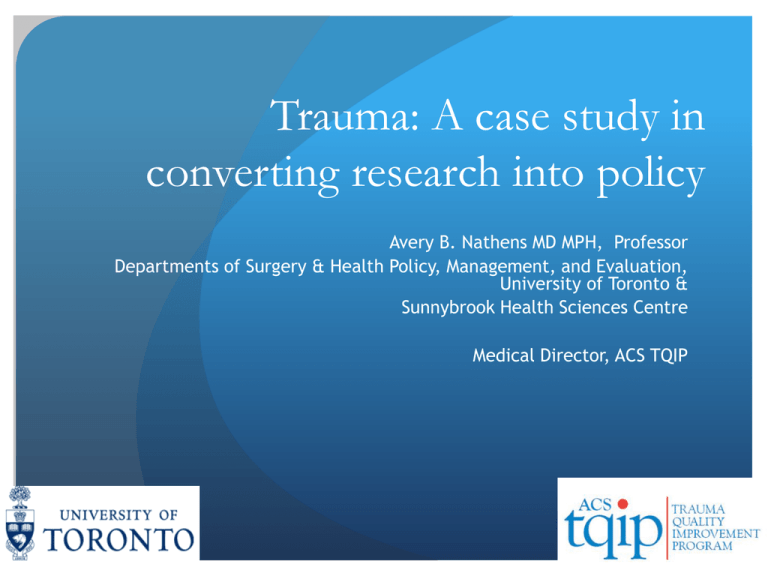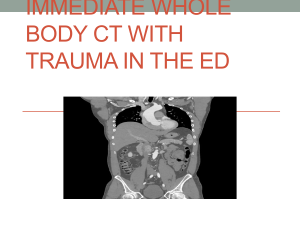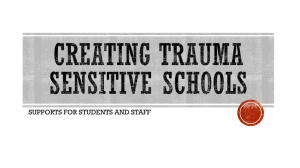
Trauma: A case study in
converting research into policy
Avery B. Nathens MD MPH, Professor
Departments of Surgery & Health Policy, Management, and Evaluation,
University of Toronto &
Sunnybrook Health Sciences Centre
Medical Director, ACS TQIP
The journey from research to policy
Trauma surgeon and intensivist
Trauma center
Trauma systems
Do trauma centers save lives?
Are trauma systems effective?
How do trauma centers
save lives
Why are trauma systems effective?
ACS Trauma Quality
Improvement Program
Regional policy
“decision maker”
ACS Trauma Systems
Consultation Guide
American Civil War: 1861
Mortality: 25%
Transport time: 72 hrs
Factors: +/- ambulance
WW I: 1914
Mortality: 8.6%
Transport time: 8 hrs
Factors: ambulance (motorized)
World War II: 1939
Mortality: 4.5%
Transport time: 4 hrs
Factors: Ambulance, Medics,
Plasma, Antibiotics
Korean War: 1951
Mortality: 2.5%
Transport time: 1.25 hrs
Factors: Helicopter, MASH
Viet Nam War: 1965-1972
Mortality 1.9%
Transport time: 27 minutes
Factors: Helicopter, Medics, Fixed wing
circa 1947
A tale of two counties
West & Trunkey, 1979
Orange County
Trauma patients transported to nearest of 39 facilities
San Francisco County
Preventable deaths: 43%
Trauma patients transported to 1 centrally located trauma
facility
Preventable deaths: 1%
NSCOT –National Study of Cost and
Outcomes in Trauma Care
Prospective cohort study
18 level I trauma centers and 51 large nondesignated centers in 15 urban regions
Extensive data collection to allow for risk
adjustment
Follow-up x 1 year
National Evaluation of the Effect of
Trauma Center Care on Mortality
N Engl J Med, 2006
N=15,000 patients
25% lower
risk of death
at one year in
trauma centers
NSCOT
Is trauma center care associated with better
functional outcomes among survivors?
SF-36, functional capacity, return to work
Modest benefit (SF-36 scores) only among those with
severe lower extremity trauma (J Bone Joint Surgery,
2008)
Are trauma centers cost effective?
One year costs: $80,232 in trauma centers vs $58, 320
in non-trauma centers
$36,319 per life–year gained or $790,931 per life
saved
50-100k per life year gained is considered acceptable
Trauma-related deaths
Airway
Breathing
Circulation – hemorrhage control
Evacuation of intracranial hematoma
..
..
..
.
ICU care
}
1st 24 hrs
44%
56%
}
All the rest
Do Trauma Centres Do It Faster?
Haas & Nathens, JACS, 2009
Time to OR (hrs)
Adusted RR of
death
Trauma
centre
0.61 (0.43-0.86)
Nondesignated
centre
Reference
Brain
Penetrating
Injury+Mass
Truncal
Effect
Injury+Shock
3.3
1.0
3.6
0.79
ICU Care & Mortality After Injury
Nathens, Ann Surg, 2006
Intensivist-model ICU
Distinct ICU service (led by an intensivist) or were
comanaged with an intensivist (a physician board-certified
in critical care)
Level 1 trauma centres: 80% intensivist model
Non-designated centres: ~10% intensivist model
Trauma mortality as a function of
ICU model
22% lower risk of death in closed ICU’s
Effects varied
Greatest effect if ICU director was a surgeon
Elderly patients derived the greatest benefit
Variations in trauma center care
Care in a trauma center is associated with a lower risk
of death after severe injury
Experience?
ICU care?
…but are all trauma centers created equal?
Variation in TBI mortality
Ttrauma center volume & outcome
Nathens, JAMA, 2001
Blunt with coma
Mortality risk
Mortality risk
Penetrating injury with shock
250 350 450 550 650 750 850 950 1050
250 350 450 550 650 750 850 950 1050
Annual patient volume
Volume & outcome: implications
Concentration of care in relatively few centers appears
to be beneficial
…but consider
Benefits only evident in the sickest patients (~5%)
Few centers in the US care for >650 ISS>15 per annum
Fewer centers limits timely access to care
Balance between access to care (benefits many) and
concentration of care (benefits few)
Why not figure out what the higher
volume centers are doing right?
ACS TQIP
Valid, Reliable,
Standardized
Data
Monitor
Performance
Promote
Structures and
Processes of
High Performers
Risk-Adjusted
Performance
Measurement
Feedback to
Trauma Centers
Trauma Quality Improvement
Traditional approach to trauma quality improvement
activities
Identify sentinel events
Compare this year’s performance to last year’s
Focused case reviews
Few insights into the quality of care
“Quality” simply reflects consistency, rather than a high
level of performance
Measurement of Quality
Process
Structure
Outcome
Quality defined by structures &
processes
Selected Structural Elements
Dedicated trauma surgeon on call (2.8)
Published backup call schedule (2.9)
Commitment of institutional governing body and staff to
become a trauma center (5.1)
Trauma medical director on call roster (5.6) and
member/participant of national/regional trauma
organizations (5.8)
Multidisciplinary peer review committee (5.18)
Operating room staffed and immediately available (11.15)
Operating microscope and cardiopulmonary bypass 24/7
(11.23)
Selected Processes
Trauma program must continuously evaluate its
processes and outcomes (5.2)
Seriously injured patients admitted to/evaluated by
credentialed trauma providers (5.12)
Attendance threshold of 80% for presence in the ED
(6.6)
Adequate attendance by general surgery at
multidisciplinary peer review (6.10)
Attending neurosurgeon available for consultation (8.5)
Neurosurgeon attends>50% of multidisciplinary peer
review committee meetings (8.2)
Where does TQIP fit?
Structure
Process
Outcome
TQIP
Mortality
Rates of PE
Rates of unplanned
return to ICU
Outcome
TQIP participation
Lessons learned
No center is a high performer in all areas
Blunt multisystem injuries
Penetrating
Shock
TBI
Elderly
Death as the primary focus for TQIP is a major limitation
Differences in philosophy of care
DOA vs DIE
Withdrawal of care (elderly, TBI)
Processes are much more interesting
Transfers to hospice
Contextual analysis
Informative data presented by center to understand
how care is delivered for specific types of patients
TBI
ICP monitoring
Tracheostomy timing
Timing of death
(withdrawal of care)
Elderly
Timing to OR for Rx of hip
fractures
Timing of death
(withdrawal of care)
Pelvic fractures
Use of angiography
Shock
(Time to hemorrhage control)
(Transfusion practices)
Isolated blunt splenic injury
Splenic preservation
Angiography
LOS – ICU, hospital
Use the data to tell a story
TBI Mortality
Excess length of stay
ICP monitoring
Time to death
Are we providing futile care?
Tracheostomy practices in TBI
Disposition after Tracheostomy
Do we have a problem with end of life care?
What makes a high performer?
High performer site visits underway
Modifiable
Protocols & procedures
Effective communication
Potentially not modifiable
Experience
Teamwork
“Get the right patient to the
right place at the right time”
Effect of regional trauma systems
10% reduction in mortality
Effect of trauma systems on motor
vehicle crash mortality
Nathens, JAMA, 2000
Legislation
Effect on crash mortality
Regional trauma system
9%
Primary restraint laws
13%
Secondary restraint laws
3%
65 mph (vs 55 mph) speed limit
7%
Administrative revocation laws
5%
Inclusive vs Exclusive Systems
Level I/II
Provides definitive care - urban
Exclusive system
Level III/IV/V
Initial care of major trauma – rural
All centers involved in quality assurance
Easier identification of need to transfer to
higher level center
Decentralized in case of disasters
Inclusive
system
MacKenzie et al., JAMA, 2003;289:1515-1522
Mortality 23%
lower
% of Hospitals
Designated as Trauma
Centers (Level I-V)
100
80
60
Mortality 7%
lower
40
20
0
ME GA FL NC UT TN MA NV PA NJ CA VA MD NY MO WV SC NH CT TX OR CO WA IA
Exclusive
More Inclusive
Most Inclusive
Challenges to trauma system design
Too much access
Too little access
Geographic variations in
MVC-mortality: Baker et al, 1987
Population density (persons/sq mile)
MVC mortality (per 100 000 persons)
558
0.2
64000
Esmerelda, NV versus Manhattan, NY
2.5
Overcoming the
challenges of geography:
Access to trauma centre
care in Ontario
Ontario, Canada
Twice the size of Texas:
416,000 sq mi
13 million people
90% rural
15% of the population
>60 miles from a specialist
Very crude system
9 adult trauma centers
No coordination
No standards for ED’s &
no lower level centers
No system PI
Do we have a problem?
How do we convince
policy makers we need to
adopt an organized system
of trauma care?
“No problem”
“Everything works fine”
“No one is dying”
No data=no problem
Time of
incident
Urban
Trauma centre
arrival
Scene transport
Time of
incident
Suburban/rural
Non trauma centre
Scene
transport
Mean – 6 hrs; 90% percentile - 11 hrs
Trauma centre
arrival
Interfacility
transport
Transfer Patients in Ontario
Average time between injury and trauma center arrival:
6 hrs, 90th percentile: 11 hrs
Linkage of ED and inpatient datasets:
20% of in-hospital deaths in the region occur in ED’s while
awaiting transfer
Population-based analysis
Mortality 23% greater in transferred patients
Linkage of ED and call center datasets:
Average time to decision to transfer is 2 hrs
The public perspective
What is the knowledge and attitudes of Ontarians with
respect to trauma care?
Telephone interviews conducted with 1000 Ontario
adults in April, 2011
Respondents targeted via Random Digit Dialing (RDD)
Interviews conducted by Pollara
Explored
Public awareness of the leading causes of death
Knowledge and experience with trauma centres/care
Perceived value and importance of trauma centres/care
Knowledge of Trauma Care in ON
Current standards do not meet the assumptions of most respondents
All hospitals in ON are inspected to
ensure they meet established set of stds
All physicians in EDs are required to
have training to care for patients with life
threatening injuries
All TC’s have a plan in place to handle a
MCI
Almost all hospitals are capable of
providing life-saving measures for life
threatening injuries
Anyone anywhere in ON can be transported
to a TC w/in 1 hr of a 911 call
Perceptions and Knowledge of
Local Hospital Services
There are opportunities to educate people about what a trauma centre is
Importance of Trauma Centre Care
Have you heard that….
Pts with serious injuries are more
likely to survive at a TC
Most hospitals are not TC’s
Are you willing to be
transported further than
the closest hospital for
TC care?
Yes- 84%
Ontario Government Priorities
A majority feel that trauma care should be a strong priority for the Ontario
Government
Reducing amount of time for patients with lifethreatening injuries to be transported to TC
Reducing wait times in Emergency Department
All TCs to have plan in place to handle large # of
pts in event of disaster like flood, earthquake,
hurricane, terrorist attack or nuclear event
Reducing wait times for elective surgery
(e.g. hernias, shoulder & hip replacements)
Base size: n=858
~22% of all
deaths occur in
ED’s before
transfer
Hospital resources
Physical resources
Intensive care unit
CT scanner
Human resources
General surgery
Orthopedic surgery
ED staffing
Emergency medicine
Mixed
Family medicine
Hospital resource
availability
General Orthopedic
surgery
surgery
ED
staffing
ICU
CT
scanner
Resource
Rich (22%)
Yes
Yes
Emergency
medicine
Yes
Yes
Resource
Variable (59%)
Yes/No
Yes/No
Mixed
Yes/No
Yes/No
Resource
Limited (19%)
No
No
Family
medicine
No
No
ED LOS and centre type
Median ED LOS: 3.5 hours (IQR 1.7 - 4.6)
Prolonged ED LOS (>75th percentile): > 4.6 hours
p<0.05
Resource
rich
(n = 1,504)
Resource
variable
(n = 2,626)
Resource
limited
(n = 406)
Median ED LOS (IQR)*
3.4 (2.0 - 5.0)
2.7 (1.6 - 4.4)
2.5 (1.5 - 3.8)
Proportion with
prolonged ED LOS*
31%
23%
15%
Prolonged ED LOS and centre type
Favours
Favours
shorter ED LOS
prolonged ED LOS
Resource-rich
2.0 (1.2 - 3.4)
Resource-variable
1.3 (0.8 - 2.2)
Resource-limited (ref)
0.0
1.0
2.0
3.0
4.0
Adjusted OR (95% CI)*
*Adjusted for sex, age, comorbidities, mechanism, ISS, severe injury by body region, year and center type
Prolonged ED LOS and resources
2.0 (1.5 - 2.8)
CT - Scanner
Intensive Care Unit
General Surgery
Orthopedic Surgery
1.4 (1.0 - 2.0)
ED - Emergency medicine
ED - Mixed
ED - Family medicine (ref)
0.0
1.0
2.0
Adjusted OR (95% CI)*
3.0
*Adjusted for sex, age,
comorbidities, mechanism, ISS,
severe injury by body region,
year and individual resources
Access to trauma care in Toronto: the
tale of triage gone awry
Toronto EMS field trauma triage
criteria
If any criteria are met and transport times<30 min, direct to
trauma center
Paraplegia/quadraplegia
Penetrating trauma to the head, neck, trunk or groin
GCS < 10
OR
Any 2 of the following:
GCS 11-14
SBP< 80
RR < 10 or RR > 24
HR < 50 or HR > 120
What is the compliance with FTT
criteria?
Geocoded scene of injury
Road network data used to calculate driving distances
from the scene to:
Scene
Closest
hospital
Closest
trauma center
Differential distance
Results
1,031 patients meeting Toronto FTT criteria
133 were closest to trauma center -excluded
898 patients for analysis
Only half (53%) were transported to a trauma center
Transport destination by Toronto neighborhood
Patient characteristics
Trauma center
n = 477
Non-trauma center
n = 421
Male
76%
54%
Age > 65
18%
51%
Mechanism
Fall
MVC
Stab wound
Gunshot wound
Other
30%
26%
16%
14%
12%
66%
7%
3%
1%
17%
p < 0.05
Patient physiology
Trauma center
n = 477
Non-trauma center
n = 421
GCS*
15
11-14
3-10
SBP < 80
14%
17%
67%
23%
13%
26%
60%
24%
Abnormal RR*
45%
22%
Abnormal HR*
38%
25%
* p < 0.05
Differential distance from trauma
center
Trauma center
n = 477
Non-trauma center
n = 421
0 - 2.5 km
69 %
31%
2.5 - 5 km
49%
51%
5 - 10 km
45%
55%
> 10 km
51%
49%
p < 0.05
Who is being disadvantaged?
Odds Ratio (95%CI)
Female
0.65 (0.45 – 0.94)
Fall (vs MVC)
0.14 (0.08 - 0.23)
Age > 65 (vs16-24)
0.28 (0.16 – 0.50)
Does lack of timely access affect
mortality?
i.e. Is there a need for change?
INCIDENT
DIRECT
GROUP
NON-TRAUMA
CENTER
TRANSFER GROUP
Transfer
UNDERTRIAGE
GROUP
ED ED-DEATH
death GROUP
TRAUMA
CENTER
What is the excess mortality
associated with undertriage?
Unadjusted OR
Adjusted OR
Adjusted OR, patients
surviving > 1 hr
1.5 (1.4-1.7)
1.2 (1.1-1.4)
20% greater
risk of dying if first
transported to a non-trauma center
1.2 (1.1-1.3)
Median time to death at non-trauma center
2.7 hours (IQR 1.2- 4.6)
From practice to policy
Trauma systems are effective
ACS Trauma systems consultation guide
Defines system expectations for regions and
states
Trauma center evaluation
TQIP
Measurement (TQIP) will become part of the ACS trauma
center verification process
Local trauma system evaluation
Chair, Ontario Trauma Systems Advisory Committee
Beginnings of an inclusive system
Reflections
The purpose of health services research is to improve
the delivery of care
The work does not end with manuscript publication
Take advantage of your expertise and position
Learn how to advocate
Work with and not against decision/policy makers
Aim for constant, gentle pressure and slow, incremental
change









